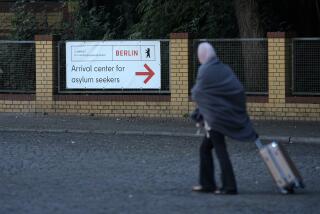COLUMN ONE : Apron Strings as Anchors : East Germany’s communism once coddled mothers. But unification has wiped out state benefits and left young women unable to go it alone. Some turn to sterilization just to compete in the job market.
- Share via
BERLIN — Outside of war, few people have gone through more complete, disorienting change than eastern Germans in the three-plus years since the collapse of the Berlin Wall. From divorce laws to driving rules, from the currency to milk cartons, precious little remains as it once was.
Motherhood is no exception.
In the past three years, birthrates in the formerly Communist east have plummeted by a staggering 52%. And while no regional statistics exist on female sterilization, anecdotal evidence points to an equally dramatic shift in the opposite direction, with the total number having risen by at least fiftyfold during the same three-year period. Meanwhile, working mothers, once a highly respected, officially nurtured species, have tumbled to the very bottom of the social status scale.
Few in eastern German society have been more badly shortchanged by the arrival of free-market democracy than have women trying to juggle the demands of career and family.
Eastern German “women in general have lost from unification, but working mothers have lost far more,” said Editha Beier, who heads a department for women’s affairs in the eastern industrial city of Magdeburg.
The collapse in the region is occurring at a time when birthrates have remained largely stable in western Germany, where the social fabric has been only slightly strained by the forces of unity.
Eastern single mothers have been especially hard hit. Independent during the Communist era--because of an array of benefits including yearlong, paid maternity leave, $20-per-month kindergartens, shorter working hours and emergency overnight child care--they today are one in five of the region’s social welfare recipients.
“The situation is catastrophic,” said Regine Hildebrandt, a minister in the Brandenburg state government whose portfolios include women’s affairs. “At one time, single mothers in the east could make it on their own. They can’t now.”
In a region where four years ago virtually all adult women were employed, the figure today has fallen to nearly half that. With total unemployment currently running at around 30%, young mothers find it nearly impossible to compete on even terms for work in a job market awash with surplus labor. Employers, wary of potential absenteeism and the state’s liberal maternity leaves, simply avoid them.
The experience of Petra Schulze, 33, is typical. Married for 13 years, with two sons, ages 9 and 12, she was trained as a telephone operator and worked her entire adult life until shortly after the Berlin Wall fell. But since then, she has been jobless, except for one brief period.
She says she continues to look for work and, with her children now a bit older, her chances are better, she feels.
“When they (employers) ask about kids, the first question is, ‘How old?’ ” she said. “It’s clear young children are a disadvantage. It may not be legal, but it definitely plays a role.”
But since last week, Schulze has an added appeal to potential employers: She has undergone sterilization. While she indicated that other factors, such as her desire for no more children and worries about the effects of a decade on the pill, were decisive in the decision, she admitted the operation would also increase her job prospects.
Not all such sterilizations are so benign. There are reports of instances in which young, childless women have been made to feel that, in the region’s present economic depression, sterilization is the price of a job.
Beier briefly made headlines nationally last year when she accused employers of not just passing over young mothers for possible jobs but also making it clear to childless young female applicants that they would be considered for work only if they underwent sterilization.
“Employers aren’t demanding the operation flat out, they’re smarter than that,” Beier said. “They just drop strong hints in that direction and make it very clear that if the prospect of children is there, they’re not interested.”
In an interview, she said the practice continues and that fighting it is extremely hard. “Anyone who submits and gets work isn’t going to turn around and bring charges against her employer,” Beier said. “Not in this climate.”
While medical sources estimate that up to one out of every three eastern German women seeking sterilization is refused by physicians on grounds of being too young or otherwise unsuitable, the numbers continue to grow.
Guenter Morack, head of the Women’s Clinic in the northern Berlin suburb of Buch, said that instead of the 10 or so sterilizations carried out there annually during the Communist era, the rate this year will run between 700 and 800. He said that pressure from the job market is just one of several factors explaining the increase.
He noted, for example, that sterilization was officially discouraged by the East German regime and that many women now undergoing the operation have waited years for it. The pill, free under communism, now costs $40 a month--a significant sum if both partners are jobless. “The typical case is someone over 30, with a family and a desire not to have more children,” he said.
But the current pressures to avoid having children are equally visible in the falling number of births at the clinic, which in the mid-1980s averaged about 3,500 annually and last year totaled only 900.
“Social uncertainty and unemployment are the main reasons” for the drop in births, Morack said. “But the demands of pregnancy and child-rearing and the environment in which they take place have all changed too.”
Schulze could confirm that. Chores at home and life with the children were once shared with her husband but no longer are. After a period of unemployment, Schulze’s husband was hired by a western German sporting goods company as a salesman, and he now travels extensively.
“He’s only home on weekends now,” she said. “Now I’m the one who does the parents’ evenings at school and deals with the household affairs.”
Her husband’s good pay, perks and a new travel freedom mark the upside of life for the Schulze family since unification. She has accompanied him to Hong Kong, Singapore and Bali, and the family is planning a trip to Florida’s Disney World in June.
But she has also lost a lot. “The sense of really being needed, of contributing as an equal is no longer there,” she said. “Sure my family needs me, but the feeling of confidence I once had is gone.”
Some observers, such as Barbara Havemann, who heads a family advisory service called Ballance in eastern Berlin, believe that the present skewing of birth and sterilization rates is merely temporary.
She argued that the drop in births reflects couples’ decisions to delay starting families, not decisions to forgo them altogether; the rise in sterilizations stems largely from a backlog of women who had wanted but were refused the operation during the Communist era.
“In a few years, when the economy settles down, we’ll see a new baby boom,” she predicted.
Others aren’t so sure. Besides economic and social turmoil, many social scientists say other factors also drive these trends--factors that imply more permanent, structural change.
Internal immigration from the depressed east to the more prosperous west, for example, is leaving the east with fewer young people. According to several estimates, easterners continue to move west at about 20,000 per month, the majority of them young and skilled.
In Brandenburg alone (total population 2.5 million), 75,000 residents younger than age 25 have left for the west since the fall of the Berlin Wall, according to figures released in January by the state’s Environment Ministry.
“There’s a terrible danger that for the first time, this immigration will create pockets of poverty, and old people in Germany similar to those that today exist in France and Italy,” said Horst Bertram, a western German sociologist who recently moved to eastern Berlin’s Humboldt University.
He and others also point to a dramatic shift in lifestyle, values and status in the east that often works against family life. In a region where couples invariably married young, had their children in their early 20s, then concentrated on careers, the sudden access to foreign travel and Western consumer goods has changed priorities.
“In the former East Germany, marriage and family had greater meaning than in West Germany, and it was state policy to help the working mother,” Bertram said. “Today, these priorities are changing.”
Added physician Morack, “Now the idea is first to achieve a degree of prosperity, then think about a family.”
The end of cheap kindergartens and other subsidized state benefits for young mothers merely reinforces this shift. Bertram noted, for example, that married female students at Humboldt University, who once found children no handicap to matriculation, have been forced to drop out because the support services simply disappeared. “Maybe some of these (support) institutions have been closed too quickly,” Bertram said.
Despite political efforts to improve conditions for women, these structural changes would seem to make any meaningful revival of popularity for motherhood unlikely in the short term. “The decline will go into the next century,” Morack predicted. “There is too much working against a recovery.”
Endangered Motherhood in Unified Germany
In the short period since the two Germanys underwent unification, women in the eastern, formerly Communist half of the nation, have seen a fundamental institution of society--motherhood--grow increasingly imperiled for a variety of complex reasons. Here are figures, for example, showing just how sharply the number of births in eastern Germany has fallen:
1989 1990 1991 1992 (thru Sept) Births in W. Berlin 21,159 22,150 21,850 16,694 Births in E. Berlin 16,937 15,446 8,712 5,831
In western states of:
1990 1992 Baden-Wuerttemberg 118,579 117,370 Bavaria 136,122 132,105 Bremen 6,895 8,639 Hamburg 16,693 19,017 Hesse 62,026 60,476 Lower Saxony 82,452 81,167 North-Rhine Westphalia 199,294 198,141 Saarland 11,210 11,029 Rheinland-Palatinate 42,732 41,587 Schleswig-Holstein 29,046 27,307 In eastern states of: Brandenburg 29,000 12,945 Mecklenburg-W. Pomerania 24,000 10,863 Saxony 50,000 25,313 Saxon-Anhalt 32,000 16,266 Thuringia 29,000 13,842
(Because of change in administrations in 1990, the year of unity, figures are not exact in the new states for that year.)
Source: Federal Statistics Office
More to Read
Sign up for Essential California
The most important California stories and recommendations in your inbox every morning.
You may occasionally receive promotional content from the Los Angeles Times.













